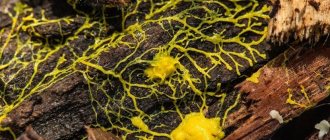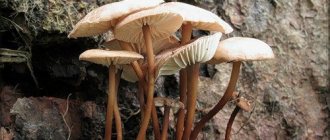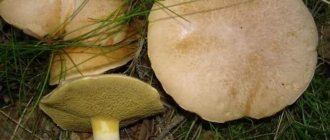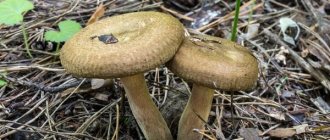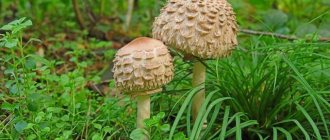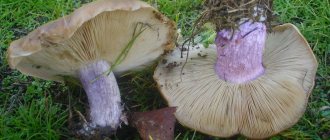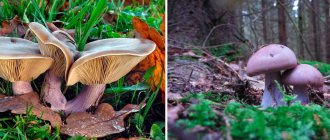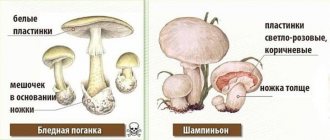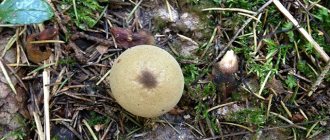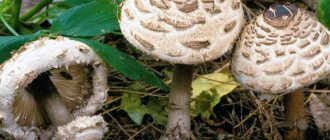Mushrooms
0
1666
Article rating
Kira Stoletova
The lamellar, conditionally edible mushroom chicken coop (blushing umbrella) is not popular. Only experienced mushroom pickers are able to appreciate its taste. The species is easily confused with others, some of which are poisonous.
Description of the mushroom coop
Mushroom Chicken Coop (Umbrella blushing): description, photo
The lamellar, conditionally edible mushroom chicken coop (blushing umbrella) is not popular.
Only experienced mushroom pickers are able to appreciate it. The species is easily confused with others, some of which are poisonous. Description of the mushroom coop
Description of the variety
The coop is also called the umbrella blush, shaggy and hen. It grows in coniferous (mainly spruce) and mixed forests. Fruits from late August until October frosts. Mushroom pickers often find large groups of umbrellas near anthills.
Description of appearance:
- cap diameter - 10-20 cm;
- the shape of the cap is first ovoid, then umbrella-shaped, the surface is scaly, reddish-brown, there are no scales in the center;
- the inside is white, turns pink when pressed and cut, the smell is light and pleasant;
- the plates are frequent, creamy in young representatives, and turn red with age.
- the length of the hollow fibrous stalk is 20 cm, 1-2 cm in girth, in new fruiting bodies it is thickened downwards, in old ones it is cylindrical;
- on the stem under the umbrella there is a narrow brownish ring.
The legs of umbrellas are usually placed in the ground layer of needles. A blushing chicken coop can easily be confused with a colorful umbrella. The variegated variety is smaller in size, its leg is covered with cracks and scales, and the ring is lighter.
Only the caps of chicken coops are edible. The legs are not eaten because of their hardness.
It is recommended to collect fruiting bodies in early September: they have the best taste and nutritional qualities.
Beneficial features
Chicken coop, like many other mushroom varieties, has beneficial properties. Fruiting bodies are rich in protein, vitamins, polysaccharides, but have low calorie content.
Chicken has the following effect on the body:
- strengthens the walls of blood vessels, improves heart function;
- stimulates muscle growth;
- increases the body's resistance to bacteria and viruses;
- stimulates brain activity;
- lowers blood sugar levels;
- helps remove toxins from the liver.
Also, mycelium components have an anti-inflammatory effect. Consumption of the product slows down the aging process of cells due to antioxidant activity.
Contraindications
Collect chicken coops away from the highways
The fruiting bodies of the red umbrella mushroom should not be consumed if there are the following contraindications:
- children under 12 years of age (the product is too heavy for a child’s stomach and can also cause allergies);
- pregnancy and lactation period;
- tendency to allergies (some components of fruiting bodies are strong allergens);
- hypoglycemia;
- problems with the functioning of the kidneys and liver;
- diseases of the stomach and intestines.
In pregnant women, mushrooms cause constipation and increased symptoms of toxicosis. Consumption of the product during feeding provokes colic. In case of gastrointestinal diseases, the absorption of the fungus sharply deteriorates, causing heaviness in the stomach and problems with stool.
You cannot collect chicken coops in dry weather, near factories, highways: fruiting bodies quickly accumulate toxic substances, their edibility decreases.
Application of the mushroom
The shaggy chicken coop has found use in cooking, traditional and folk medicine. It is prepared in different forms and added to medications for a number of diseases.
Use in cooking
Chicken coop tastes like champignon. After mandatory heat treatment for 10-15 minutes. fruiting bodies are added to salads, soups, and fried. The product is also salted and pickled.
Chicken coop is a dietary product. It is recommended to be added to the diet of athletes.
Freshly picked chicken can be stored in the refrigerator, without polyethylene, for 2-3 days. Fruiting bodies pickled in jars are best consumed within a year.
Application in medicine
The use of umbrellas in medicine is the subject of scientific research around the world. They are used as a prophylactic against cancer, tuberculosis and viral infections.
Extracts of fruiting bodies are used in cosmetology to treat skin inflammation. They reliably help get rid of acne. Lotions made from alcohol tinctures are used to rejuvenate the skin.
Mushroom umbrella
Edibility and consumption
The scales located on the tops must be cleaned. Cooking is accepted in any condition, even raw. Belongs to the champignon family. The stem can be described as tough and fibrous, so the bottom of the mushroom is not used when preparing various dishes. The taste is similar to champignons and resembles chicken meat. You need to be careful with poisonous doubles. For consumption, it often requires pre-processing. There is a pleasant aroma.
The French like to fry mushrooms in a container with vegetable oil, with the addition of a certain amount of herbs or spices. The cooking process is similar to pancakes. In advance, the cap can be immersed in breadcrumbs, flour or beaten egg. Belongs to the champignon family. You should be careful when collecting.
You can cook in the oven or make a barbecue with the addition of herbs, pepper or garlic to taste. The disadvantage of these specimens is that they tend to get very fried with these cooking methods. The fresh and dry appearance is useful in creating delicious soups. Young specimens lend themselves well to pickling and salting and are ideally combined with other ingredients in salads or sandwiches.
Sometimes they are even eaten raw. It has a number of useful properties. The taste is reminiscent of chicken meat. Mycologists are still studying the features. You should be careful when collecting. For consumption, it often requires pre-processing. There is a pleasant aroma.
How to cook chicken coop mushrooms
Mother nature gives a huge amount of benefits, demanding in return only careful treatment. Each region is rich in different types of dishes, which in the skillful hands of housewives turn into exquisite dishes, individual culinary masterpieces
Mushrooms have always occupied an important place at the festive table. And not in vain, because with all their availability and popularity, they contain a lot of vitamins A and B, microelements and beneficial properties that have a beneficial effect on the body
You can prepare chicken coop mushrooms in various ways.
There are several general preparation rules that also apply to blushing umbrellas:
- clean from forest dirt;
- rinse under running water;
- dry, salt, boil.
Well, then a flight of fancy - fried, boiled, stewed, marinated, in batter, with or without sauce. There are many recipes for preparing chicken coop mushrooms. At the same time, every housewife strives to add her own flavor to the dish.
There are many recipes for cooking mushrooms
- https://fermoved.ru/gribyi/kuryatnik-zontik-krasneyushij.html
- https://domsad.guru/griby/pic919_grib-kuryatnik.html
- https://fermilon.com/sad-i-ogorod/griby/grib-kuryatnik-zontik-krasneyuschiy-opisanie-i-foto.html
- https://gribnik.info/grib-kuratnik/
Harm and contraindications
Contraindications for consuming chicken coop mushrooms are the same as for any mushrooms:
- children under 10 years old;
- pregnant women and mothers during lactation;
- for allergy sufferers;
- persons suffering from gastrointestinal diseases.
It is prohibited to collect mushrooms (and eat them) near factories, chemical warehouses and large highways. Remember that mushrooms are like sponges, absorbing toxins and poisons!
Chicken coop mushroom (reddened umbrella): description and distribution locations
A good knowledge of little-known edible mushrooms gives you a chance to collect good “catch” even in the most visited forests. As a rule, “quiet hunters” avoid the shaggy, long-legged umbrella - a mushroom called the “chicken coop”. Its fried flesh actually tastes like chicken.
Description
The edible mushroom red umbrella (Macrolepiota rhacodes), also known as chicken coop or shaggy umbrella, has the following species characteristics:
- The color of the cap is brownish or grayish-brown, more or less light. As it grows, its surface is covered, like tiles, with large pinkish or grayish-brown scales, giving the mushroom a characteristic “tousled” appearance. The shape of the cap at an early stage of development is spherical, later it becomes spread out in the shape of an umbrella, with a wide brownish tubercle remaining in the center. The diameter reaches up to 20 cm;
- loose, frequent, light plates are attached to the collarium - a ring-shaped protrusion that covers the place where the stem meets the cap. When touched, the plates turn carrot-colored;
- white spores;
- a light brown, smooth, hollow cylindrical leg with a tuber base and a movable grayish-white ring has a fibrous structure; Often it sinks deeply into fallen needles. Maximum thickness 2 cm, length - 25 cm;
- thick, loose white pulp with a faint pleasant smell and the same taste turns red at the break - this feature is most noticeable at the cut of the stem.
Distribution and fruiting period
The blushing umbrella most often grows in groups, more or less numerous. It inhabits humus-rich soils in mixed and coniferous forests with the presence of spruce, and is often found near anthills. The fruiting bodies ripen by July, mass fruiting is observed in the last ten days of August, the second wave of numbers occurs in October.
Similar species
A related edible mushroom, the variegated umbrella (Macrolepiota procera), can be confused with the blushing umbrella. It is, however, much larger, not so shaggy, has a not smooth, but scaly leg with small cracks and flesh that does not turn red at all when broken or cut. The characteristic “blush” of the cut stem distinguishes the blushing or shaggy umbrella from other edible umbrella mushrooms - the very light maiden mushroom (Leucoagaricus nympharum) and the miniature thin one (Macrolepiota gracilenta).
Edibility
The caps of blushing umbrellas are mainly suitable for culinary use, since the flesh of the legs is noticeably tougher. The collected mushrooms are freed from forest debris, scales are removed, washed, and then boiled and fried without any additional processing. They are suitable for drying and pickling. Connoisseurs and connoisseurs especially recommend preparing a shaggy umbrella by frying it in a sufficient amount of oil. Then its flesh acquires the most pronounced taste of chicken.
https://youtube.com/watch?v=TjbtFih4AV0
During the mushroom season, the red umbrella is a fairly easy forest prey, because it grows in large groups, and not everyone knows the edibility of this mushroom.
It is only important to remember that in some regions this mushroom is listed in the Red Book
Chicken coop mushroom: where does it grow and can it be eaten?
The chicken coop mushroom is an edible species belonging to the Champignon family. It has a certain number of poisonous counterparts and inedible varieties, which you need to be aware of when harvesting. It has a number of useful properties.
The mushroom is edible. The chicken coop also has another name - an umbrella, which it received due to its appearance and characteristic, memorable shape. The pulp has a taste reminiscent of chicken meat. Mycologists are still studying the features. You should be careful when collecting.
Description of the species
The coop is also called the umbrella blush, shaggy and hen. In general, the specific scientific name of the mushroom is the blushing umbrella, or Chlorophyllum rhacodes in Latin. It grows in coniferous (mainly spruce) and mixed forests. Fruits from late August until October frosts. Mushroom pickers often find large groups of umbrellas near anthills.
Description of appearance:
- the diameter of the cap is 10-20 cm, but for some “record holders” it can reach 30 cm;
- the shape of the cap is first ovoid, then umbrella-shaped, the surface is scaly (or more precisely, shaggy, from which one of its popular names comes), reddish-brown, with no scales in the center;
- the pulp is white, turns pink when pressed and cut, the smell is light and pleasant;
- hymenophore: the plates are frequent, creamy in young representatives, and turn red with age.
- the length of the hollow fibrous stalk is 20 cm, 1-2 cm in girth, in new fruiting bodies it is thickened downwards, in old ones it is cylindrical;
- on the stem under the umbrella there is a narrow brownish ring.
The legs of umbrellas are usually placed in the ground layer of needles. A blushing chicken coop can easily be confused with a colorful umbrella. It should be taken into account that the motley umbrella is smaller in size, its leg is covered with cracks and scales, and the ring is lighter.
Irina Selyutina (Biologist):
Today, the position of the red umbrella in mushroom taxonomy is twofold. Some sources claim that, according to phylogenetic studies, the closest relatives of the red umbrella mushroom include the American species Chlorophyllum molybdites, and not the motley umbrella. Therefore, it was proposed to include the fungus in the genus Chlorophyllum, removing it from the genus Macrolepiota and calling it Chlorophyllum rhacodes. But the famous Russian mycologist M. Vishnevsky, in his book “Mushrooms. Mini-expert” (M., 2014), still believes that the blushing umbrella should be classified in the genus Macrolepiota, or Umbrella Mushroom. Both of these genera belong to the Champignon family.
Sometimes the chicken coop mushroom is confused with fly agarics. To prevent this from happening, you must remember the following points:
- Scales (remnants of the cover) on the cap: in fly agarics their color is always lighter than the main background of the cap, and in an umbrella they are darker than the main color.
- The plates of the hymenophore: in the chicken coop are attached to a special cartilaginous ring at the junction of the cap and legs - the collarium.
- Ring on the stem: in umbrella mushrooms (and the blushing umbrella is no exception), it moves freely along the stem, while in fly agaric mushrooms it is attached.
- Leg: at the base of the leg there is something like a “bulb” - a slight thickening, but there is no volva (the remnant of the common veil).
Only the caps of chicken coops are edible. The legs are not eaten because of their rigidity.
It is recommended to collect fruiting bodies in early September: at this time they have the best taste and nutritional qualities.
Description of appearance
| Hats | They have an ovoid shape, then open up and take on prostrate conical shapes, reminiscent of open umbrellas. In open views, conical elevations can be observed at the tops in the middle part. The hat is grey, off-white or brown. In the center it becomes darker in color than the rest of the surface. Brown scales and fairly large flakes cover the cap, reaching from 15 to 30 cm in diameter. Very often you can find individuals with a cap reaching 40-45 cm. |
| Legs | Quite tall, can reach up to 35 cm and above. The interior can be described as hollow, dense, colored in brown shades. Scales of brown flowers cover the stem. Under the caps there are wide white rings that can move freely along the height of the legs. |
| Pulp | The flesh of the caps can be described as soft, white, loose, cotton-like in old individuals. It is characterized by a pleasant, pronounced mushroom taste and smell. Mushroom aromas are present, the flesh of the legs can be described as tough and pleasantly smelling. It has a gray-brown color. The taste is reminiscent of chicken meat. There is a pleasant aroma. |
| Spore-bearing layers | Lamellar. The plates can be called wide, adherent to the collarium (the central cartilage is called the collarium). They are creamy white in color and tend to turn redder over time. Spore powder is white in color and has smooth and round spores. |
Chicken mushroom (umbrella): red_lemur — LiveJournal
I must admit that I don't know its official name and we call it chicken mushroom in our family circle (including a few dedicated friends). We call it this because of its unusual taste, extremely close to chicken meat. My vegetarian daughter is surprised every time: “What a strange, long-forgotten taste!”
The mushroom comes in two types. An open umbrella that did not have time to open.
The mushroom has a skirt, and the leg ends in a thickening. I smiled at the rest of the distinctive features when I reread them. :)))
The cap is lamellar and may or may not have growths in the form of gray or white scales. The leg can be painted gray, it can be pockmarked, or it can be pure white. When cut, most mushrooms turn pink, but there are also some that remain white. In short, maybe this way, or maybe that way.
In adult (opened) mushrooms, only the cap is edible. The sheath becomes too stiff. But for young people, you can eat the entire mushroom.
They grow both singly and in groups.
They are quite high, so they are clearly visible if you sit down and look parallel to the ground.
I know people who throw them in a frying pan and, after frying them for a few minutes on each side and adding a little salt, serve them. We cook them first. We do this rather to reduce the size. Those. throw it into boiling water for a couple of minutes, and after the mushroom has reduced in size (and the caps of open umbrellas can be quite large), transfer it to the frying pan.
Without exaggeration, I will say that this is one of the most delicious mushrooms I have ever encountered. Those. it tastes fundamentally different from all the others.
Nevertheless, I strongly recommend that you carry out your first collection of these mushrooms in the company of a person who has collected them at least once before. Because without a certain skill, despite the obvious differences, umbrellas can still be confused with toadstools...
PS Just in case, let me clarify that these are not the mushrooms after which people talk to plants...
